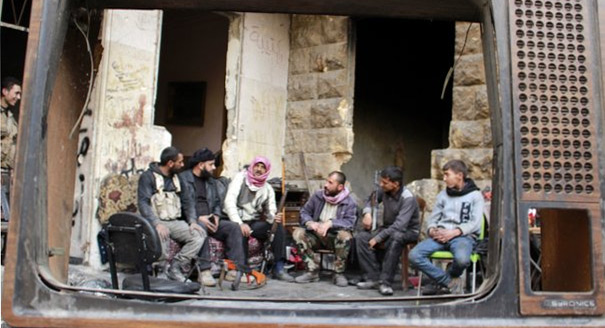For more background, please refer to the Syrian Islamic Council, which was published yesterday.
The effort to establish the Syrian Islamic Council (SIC) as the central Syrian religious authority within the opposition has proved to be contentious, arousing hostile reactions on the part of individuals who failed to secure positions on the board or in the council at large. One of the most vocal of these detractors was Salafi television preacher Adnan al-Aroor, who accused the SIC of harboring pro-regime and pro-Shia figures.
The animosity of the notoriously Saudi-aligned al-Aroor toward the SIC must be situated in the broader context of the SIC’s distance from Riyadh and alignment with the Qatar-Turkey axis. The League of the Ulema of Sham (LUS), which constitutes one-third of the council’s board, and the SIC held their inaugural meetings in Doha and Istanbul, respectively. The SIC meeting was organized with the support of the Humanitarian Relief Foundation, an NGO associated with Turkey’s ruling Justice and Development Party.
In a November 2013 interview with the Turkish news agency Anadol, LUS Vice President Sheikh Osama al-Rifai stressed that “except for Qatar and Turkey,” the so-called Friends of Syria, an alliance of largely Gulf and Western countries, is “plotting against the Syrian people.” Likewise, Sururi Salafis, activist Salafis who differ from their quietist counterparts in their acceptance of contentious politics, are distrusted by Saudi Arabia and, accordingly, enjoy cordial relations with Qatar. Therefore, in the struggle between Riyadh and Doha for control of the Syrian opposition, the establishment of the SIC clearly weighs in favor of the second contender.
The Islamic Front, Syria’s largest rebel coalition, initially joined the SIC but announced its withdrawal ten days after the Istanbul meeting, decrying the exclusion of military organizations from the SIC. This expression of disappointment was driven by the failure in the board elections of Ayman Abu al-Tut (also known as Abu al-Abbas al-Shami), the chief scholar of the Islamic Front’s leading faction Ahrar al-Sham. Zahran Alloush, leader of the front’s other pillar, the Army of Islam (Jaysh al-Islam), echoed the sectarian language of al-Aroor—not coincidentally, one of Alloush’s fundraisers—by accusing “those who confiscate the religious pulpit in Syria” of not having a clear stance on “the Nusayris [Alawites] and Rafida [Shia].”
Behind this firebrand rhetoric stands, among other things, a recent conflict with SIC board member Sheikh Riyad al-Kharqi, who was briefly arrested in March by the Army of Islam following its storming of the headquarters of the Damascus Sharia Committee in Eastern Ghouta. The dispute was eventually brought to an end by the mediation of Moaz al-Khatib, a leading opposition figure affiliated with the LUS.
Why Does It Matter?
Divisions over the formation of the SIC suggest that the Syrian opposition will have to wait to see the emergence of a unified Sunni religious authority within its ranks. However, these divisions are revealing of fault lines that may play a major role in Syria’s future.
Although not absent, the Saudi-Qatari rivalry is not central here. Ahrar al-Sham’s proximity to Doha has not prevented the group from breaking with the SIC, and the Saudi-backed Syria Revolutionaries’ Front, a Syrian rebel alliance, has expressed support for the SIC. More crucial differences are partly ideological, since the coalition of traditionalist, reformist, Muslim Brotherhood–minded, and Sururi scholars that controls the SIC has closed ranks against the mutually opposite brands of Salafis that currently dominate the Islamic Front—that is, Ahrar al-Sham’s “light jihadis” and the Army of Islam’s Saudi-aligned traditional Wahhabis.
Remarkably, the withdrawal of the Islamic Front occurred a few days after a statement of support for the SIC issued by two other Islamist rebel coalitions, the Damascus-based Ajnad al-Sham and the Aleppo-centered Mujahideen Army. Both organizations are non-Salafi and rather follow traditionalist, “Muslim Brotherhoodesque” interpretations of Islam. The Mujahideen Army recently issued a strikingly un-Islamist charter.
Beyond religious doctrines, the conflict over the SIC reflects a more structural divide between two models of the civilian-military relationship. What distinguishes Ahrar al-Sham and the Islam Army (as well as the Islamic State in Iraq and the Levant and the Nusra Front, both jihadi opposition groups) from mainstream rebel groups, as well as from the other branches of the Islamic Front, is that they possess their own religious authority (marjaiyya) and consequently do not defer to external references such as the SIC’s members. This inevitably makes the SIC uncomfortable with such factions. It also provides for smoother relations between the SIC and groups like Ajnad al-Sham and the Mujahideen Army, which are all the more eager to recognize the SIC’s spiritual leadership because they lack embedded religious authorities.
Competing Models of the Judiciary
Differences over the nature of religious authority have had important consequences in the judicial realm, where the mainstream ulema and Islamic Front affiliates have promoted conflicting models: whereas the ulema have encouraged the establishment of independent judicial bodies, the Islamic Front has favored the fusion of military and judicial structures.
In Aleppo, in particular, this difference has been illustrated by the rivalry between the independent Unified Judicial Council and the Sharia Committee jointly run by the Islamic Front and the Nusra Front. The Army of Islam assaulted the Damascus Sharia Committee to defend its judicial arm, the Consultative Council, against the Shari Committee’s attempt to establish a unified and independent judicial authority in the suburbs of the capital. Tellingly, both Ajnad al-Sham and the Mujahideen Army have sided against the Islamic Front’s ambitions of judicial control.
With the SIC’s avowed goal to work for the unification of judicial bodies in rebel-held areas, disagreement is likely to grow not between religious and military leaders but within each of these groups, between advocates and opponents of the separation of civilian and military powers.
Thomas Pierret is a lecturer in contemporary Islam at the University of Edinburgh and the author of Religion and State in Syria: The Sunni Ulama from Coup to Revolution (Cambridge University Press, 2013). He has previously written for Syria in Crisis on the Geneva II Syrian peace process.






